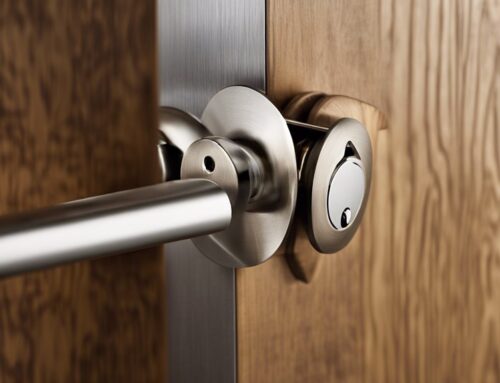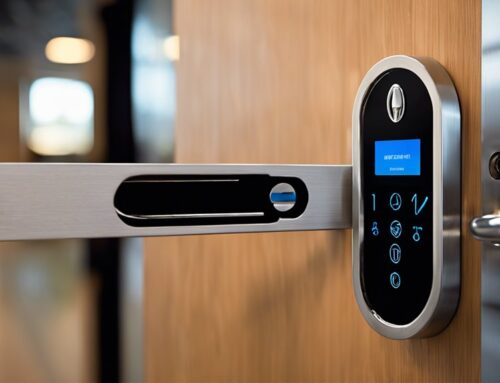Magnetic keyed locks, with their innovative use of magnetic-coded technology, provide a secure and reliable solution for protecting valuable assets.
By employing small magnets to operate internal tumblers, these locks offer resistance against traditional lock picking methods.
The mechanical and magnetic pins within the lock align precisely with the corresponding ones in the key, ensuring effective key control.
Additionally, the cost effectiveness and anti-picking features of magnetic keyed locks make them a desirable choice for those seeking enhanced security measures.
How Magnetic Keyed Locks Work
Magnetic keyed locks work by utilizing small magnets embedded in the keys to manipulate the internal tumblers of the lock, allowing for secure and efficient unlocking. These magnetic key mechanisms are designed to provide a high level of security while also offering convenience.
The magnetic key applications are diverse, ranging from residential and commercial buildings to vehicles and safes.
The magnetic key mechanism consists of multiple magnets with different polarity and strength, which enable thousands of different combinations per key. When the correctly matched key is inserted, the magnets push or pull the internal tumblers to the appropriate level, releasing the lock. The magnetic pins used in these locks are made with permanent magnets, ensuring they stay magnetized and are not affected by other magnetic fields.
One of the key advantages of magnetic keyed locks is their resistance to traditional lock picking techniques. The magnetic operation of the tumblers makes it impossible for standard lock picking tools to manipulate the lock. Additionally, magnetic keys cannot be easily reproduced by locksmiths using sight or other human sensed information, ensuring key control and minimizing the risk of unlawful key duplications.
In terms of cost effectiveness, magnetic keyed locks offer significant advantages compared to high-security locks with similar features. The manufacturing costs are significantly reduced due to the simplicity of embedding magnets in keys and locks. This makes magnetic keyed locks an affordable option for individuals and businesses looking for reliable security solutions.
Overall, magnetic keyed locks provide a secure and efficient unlocking mechanism, making them suitable for a wide range of applications. Their anti-picking and anti-bumping features, along with key control and cost effectiveness, make them a preferred choice for those seeking reliable security solutions.
Advantages of Magnetic Keyed Locks
Embedded magnets in the keys and locks of magnetic-coded systems provide advanced security features.
Compared to traditional pin tumbler locks, magnetic keyed locks offer several advantages.
First, they are highly resistant to lock picking due to the magnetic operation of the tumblers. This eliminates the risk of unauthorized access through traditional lock picking techniques.
Additionally, magnetic technology prevents lock bumping by eliminating the transmission of kinetic energy.
Key control is also enhanced with magnetic keyed locks. Limited access to key blanks and unique magnetic coding minimize the chances of unlawful key duplications.
Moreover, magnetic keyed locks are cost-effective compared to high-security locks with similar features, as the manufacturing costs are significantly reduced.
These locks find application in various industries where security is of utmost importance, such as banking, healthcare, and government institutions.
Security Features of Magnetic Keyed Locks
When using a magnetic-coded lock, the alignment of the key’s pins and poles is crucial for secure access.
Magnetic keyed locks utilize digital key technology to provide enhanced security features.
The impact of magnetic keyed locks on the locksmith industry has been significant. These locks prevent traditional lock picking methods, making them highly secure.
The magnetic operation of the tumblers eliminates the possibility of lock bumping, providing added protection against forced entry.
Additionally, the limited access to key blanks and unique magnetic coding ensures key control, reducing the risk of unlawful key duplications.
The manufacturing costs of magnetic keyed locks are also more cost-effective compared to high-security locks with similar features.
However, the complexity of manufacturing and limited supply of blanks can pose challenges for locksmiths.
Overall, magnetic keyed locks have revolutionized the locksmith industry by offering advanced security features and cost-effective solutions.
Calculating Key Combinations for Magnetic Keyed Locks
Calculating the number of key combinations for magnetic-coded locks involves considering the number of conventional pin-tumbler lock combinations and the number of pairs of embedded magnets. The equation used to determine the number of magnetic-coded lock key combinations (N) is N = C * 4^m, where C represents the number of conventional pin-tumbler lock combinations and M represents the number of pairs of embedded magnets. This mathematical equation allows for a vast number of potential key combinations, making magnetic-coded locks highly secure.
Manufacturing magnetic-coded locks does come with some complexity. Special tools and procedures are required to embed the magnets in both the keys and the locks. This adds an extra layer of manufacturing complexity compared to traditional locks. However, despite this complexity, magnetic-coded locks offer many advantages such as anti-picking and anti-bumping features, key control, and cost-effectiveness.
Disadvantages and History of Magnetic Keyed Locks
The manufacturing complexity of magnetic-coded locks requires special tools and procedures to embed the magnets, which can increase costs and make key duplication more difficult and expensive. This presents a significant manufacturing challenge for magnetic keyed lock manufacturers.
However, despite these challenges, there are ongoing efforts to develop future advancements in magnetic lock technology. Researchers are exploring new materials and manufacturing techniques that could simplify the embedding process and reduce costs.
Additionally, advancements in digital technology may offer alternative solutions to traditional magnetic-coded locks, such as biometric authentication or smart locks. These future developments aim to address the manufacturing challenges and make magnetic keyed locks more accessible and cost-effective for consumers while maintaining their high level of security.
Frequently Asked Questions
Are Magnetic Keyed Locks More Secure Than Traditional Pin-Tumbler Locks?
Magnetic keyed locks offer enhanced security compared to traditional pin-tumbler locks. The benefits of magnetic keyed locks include anti-picking and anti-bumping features, ensuring greater protection against unauthorized access.
Key control is also improved, as limited access to key blanks and unique magnetic coding minimize unlawful key duplication. Moreover, magnetic keyed locks are cost-effective, as manufacturing costs are significantly reduced compared to high-security locks with similar features.
These advantages make magnetic keyed locks a reliable choice for those seeking enhanced security measures.
Can Magnetic Keys Be Easily Duplicated?
Magnetic keys can be easily duplicated, posing a potential security risk. The process involves creating a copy of the key by measuring the magnetic field produced by the original key and replicating it onto a new key. This can be done using specialized equipment and techniques.
However, it is important to note that magnetic key duplication is typically not as common as traditional key duplication methods. To ensure maximum security, it is advisable to use additional security measures such as key control and restricted access to key blanks.
How Do Magnetic Keyed Locks Prevent Lock Bumping?
To prevent lock bumping, magnetic keyed locks utilize advanced magnetic-coded technology. The magnetic pins embedded in the lock’s tumblers and the corresponding magnetic pin locations on the key must align perfectly for the lock to open.
This unique magnetic operation eliminates the transmission of kinetic energy that is typically used in lock bumping techniques. By incorporating this feature, magnetic keyed locks offer enhanced security compared to traditional locks.
Additionally, they provide advantages such as anti-picking, key control, and cost-effectiveness.
What Are the Limitations of Magnetic-Coded Technology?
The limitations of magnetic-coded technology include vulnerabilities to certain types of attacks.
While magnetic keyed locks provide advantages such as anti-picking and anti-bumping features, they are not completely immune to all forms of manipulation. Skilled attackers may still be able to exploit weaknesses in the magnetic pins or other components of the lock.
Additionally, the manufacturing complexity of embedding magnets in the keys and locks can make the process more challenging and costly.
Are Magnetic Keyed Locks More Expensive Than Traditional Locks?
Magnetic keyed locks can be more expensive than traditional locks. While they offer advantages such as anti-picking and anti-bumping features, their manufacturing complexity and limited key control can increase costs. The installation process requires special tools and procedures to embed magnets in keys and locks.
However, magnetic keyed locks are still cost-effective compared to high-security locks with similar features. It’s important to carefully consider the pros and cons of magnetic keyed locks before making a decision.






